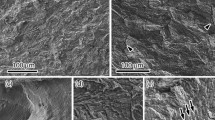Abstract
Tensile tests were performed on an Al-Cu-Mg alloy, 2124, in plate form, after aging to seven different tempers. Cathodic charging with hydrogen caused no significant loss of ductility for any temper, in contrast, for example, to 7075. Simultaneous straining and cathodic charging did, however, result in reduction in area losses up to 25 pct. The fracture mode was not altered by hydrogen. In general, the results conformed to the framework established through investigation of 7075 alloys, in that the underaged microstructures were the most susceptible to hydrogen embrittlement; this susceptibility can be explained in terms of microstructure and slip behavior.
Similar content being viewed by others
References
R. J. Gest and A. R. Troiano:L'hydrogen dans les Metaux, Editions Science et Industrie, Paris, 1972, pp. 427–32.
R. J. Gest and A. R. Troiano:Corrosion, 1974, vol. 30, pp. 274–79.
J. Albrecht, B. J. McTiernan, I. M. Bernstein, and A. W. Thompson:Scripta Met., 1977, vol. 11, pp. 393–97.
J. Albrecht, A. W. Thompson, and I. M. Bernstein:Metall. Trans. A, 1979, vol. 10A, pp. 1759–65.
M. Taheri, J. Albrecht, I. M. Bernstein, and A. W. Thompson:Scripta Met., 1979, vol. 13, pp. 871–75.
M. O. Speidel and M. V. Hyatt:Advances in Corrosion Science and Technology, Plenum, New York, NY, 1972, vol. 2, pp. 115–335.
A. W. Thompson and I. M. Bernstein:Advances in Corrosion Science and Technology, Plenum, New York, NY, 1979, vol. 7, pp. 53–175.
A. W. Thompson and I. M. Bernstein:Reviews on Coatings and Corrosion, 1975, vol. 2, pp. 2–44.
J. A. S. Green, H. W. Hayden, and W. G. Montague:Effect of Hydrogen on Behavior of Materials, A. W. Thompson and I. M. Bernstein, eds.,TMS-AIME, New York, NY, 1976, pp. 200–15.
R. E. Swanson, A. W. Thompson, I. M. Bernstein, and J. L. Maloney:Hydrogen Effects in Metals, TMS-AIME, Warrendale, PA, 1981, pp. 459–66.
S.W. Ciaraldi: Ph.D. Thesis, University of Illinois at Urbana-Champaign, 1980.
J.M. Silcock:J. Inst. Metals, 1960-61, vol. 89, pp. 203–10.
J. C. Williams, A. W. Thompson, and R. G. Baggerly:Scripta Met., 1974, vol. 8, pp. 625, 30.
W. A. Mclnteer, A. W. Thompson, and I. M. Bernstein:Acta Met., 1980, vol. 28, pp. 887–94.
J. Albrecht and G. Lütjering:Influence of Microstructure on Fatigue Crack Propagation Rate of Aluminum Alloys, Report ESA-TT-418, European Space Agency [Access No. N78-18203] DFVLR, Cologne, W. Germany, 1974.
G. M. Scamans, R. Alani, and P. R. Swann:Corros. Sci., 1976, vol. 16, pp. 443–59.
N.E. Paton and A. W. Sommer:The Microstructure and Design of Alloys (Proc. 3rd ICSMA, Cambridge), Inst. Metals, London, 1973, vol. 1, pp. 101–08.
Author information
Authors and Affiliations
Additional information
Formerly Research Associates at Carnegie-Mellon University.
Rights and permissions
About this article
Cite this article
Hardwick, D.A., Taheri, M., Thompson, A.W. et al. Hydrogen Embrittlement in a 2000-Series Aluminum Alloy. Metall Trans A 13, 235–239 (1982). https://doi.org/10.1007/BF02643313
Received:
Issue Date:
DOI: https://doi.org/10.1007/BF02643313




